Camellias are often the anchor of the garden. They stand tall with glossy evergreen leaves and elegant, eye-catching blossoms that appear when everything else is still in its winter sleep.
They act as both a stalwart background plant and, at other times, a striking focal point.
There’s no question in my mind about why camellias are at the top of so many growers’ best-of lists.
Another reason people can’t get enough of camellias? They’re generally problem free. They don’t often succumb to diseases, and pests are rarely a significant problem.
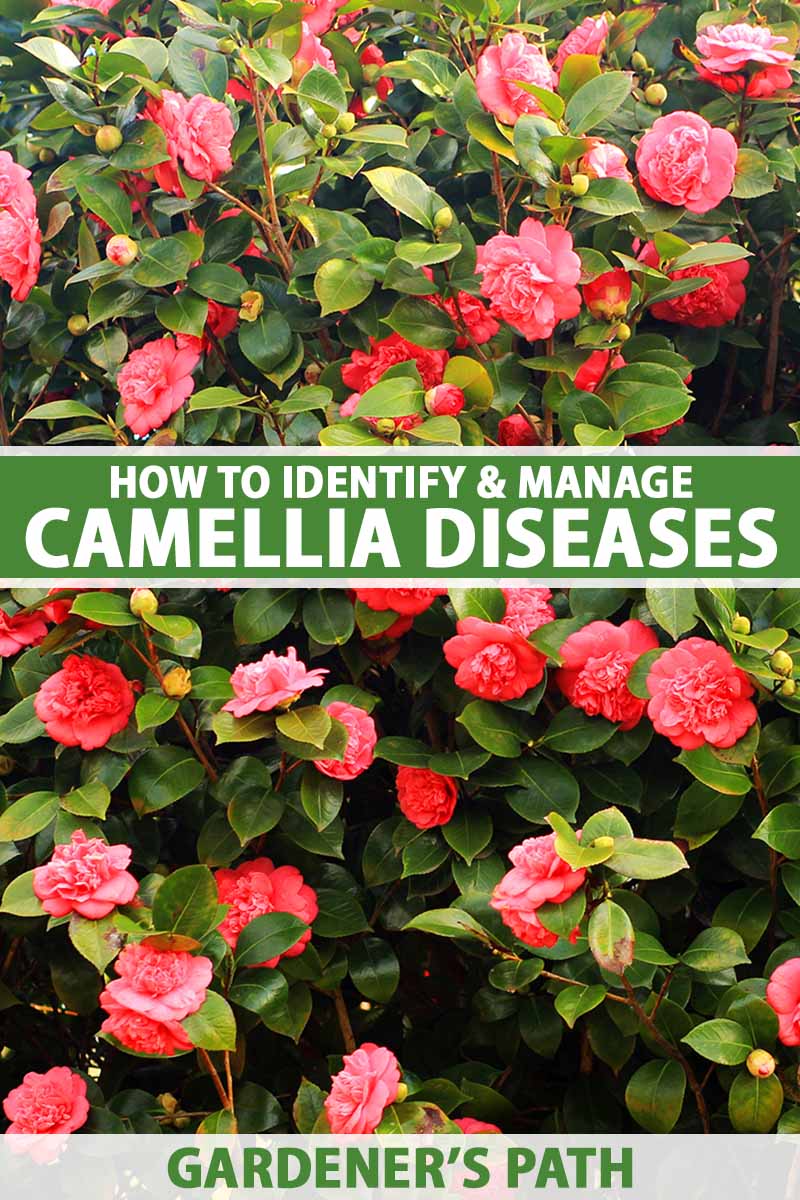
We link to vendors to help you find relevant products. If you buy from one of our links, we may earn a commission.
Don’t get me wrong. It’s not like camellias never have disease problems. But when they do strike, it’s usually something we can safely ignore or treat easily.
If you’re seeing something weird going on it’s crucial that you are able to identify the problem, or in this case, the specific disease.
That’s how you’ll know how much you should panic and what steps you can take to fix it.
If you need a quick refresher on general camellia care, see our guide. Here are the diseases that we’re going to discuss in this article:
7 Common Camellia Diseases
There are a few physiological disorders that mimic diseases, and these are worth a quick note as well before we begin.
Scab isn’t technically a disease, it’s a physiological condition. But it looks like a disease has set in, with corky, irregular brown spots that appear on the undersides of leaves.
Typically, the problem starts as water-soaked lesions on the underside of the leaves, but we rarely notice scab at this stage. It’s not until the corky growths develop that most of us realize something is going on.
It’s pretty common and appears in areas with poor drainage and poor air circulation.
Sunscald or sunburn is also common. Leaves that are facing south or southwest will take on a papery tan or brown appearance.

This often happens after you’ve had a cloudy period followed by heat and sun. Or it might occur after you trim back a nearby tree or shrub that was providing shade.
New leaves will be better adapted to the change and will come in healthy.
A lack of nitrogen or iron can also cause the leaves to turn yellow. Once the plants are fed, they’ll recover and grow new, healthy leaves.
Now, let’s examine our first potential disease:
1. Algal Leaf Spot
The algal plant pathogen Cephaleuros virescens can sometimes be found on camellias, but typically only on those that are already stressed by some other pest or disease.
In order for this disease to really take hold, it needs two things: direct sunlight and lots of moisture.
When both are present, raised silvery-green, grayish-green, or tan spots and splotches develop on the leaves. It can also cause spots on stems.

If a damaged branch or twig has a wound that the algae can enter through, it can cause cankers that result in swelling. This swelling cuts off water to the rest of the area, and the twig or stem might die.
This pathogen may infect hundreds of plant species, so it’s entirely possible that other specimens in your garden might be infected as well. It doesn’t appear west of Texas or in the northern part of the US, so if you’re living in California, consider something else.
A small area of infection can be treated with pruning, but for a larger area or if the camellia shows symptoms throughout, use a copper fungicide every two weeks until no new symptoms develop.
Copper fungicide is one of those things that I always keep around. It works on so many fungal diseases, including a few others on this list.
If you don’t already have some, I highly recommend picking some up.
Lots of well-known garden brands like Bonide and Monterey make their own.
Bonide Liquid Copper Fungicide
Arbico Organics carries Bonide’s Liquid Copper Fungicide in 32-ounce ready-to-use sprays, 16- and 32-ounce ready-to-spray bottles, and 16-ounce concentrate.
2. Dieback and Canker
For those living in the south or along the Atlantic coast, dieback and canker can be a severe issue. This disease loves it hot and humid.
The fungus that causes this disease goes by two names: it’s Colletotrichum gloeosporioides when it’s in its asexual state, and Glomerella cingulata when it’s reproductive. I’m sure growers dealing with this problem have some other choice names for this disease as well…
When present, the stems of the camellia will form cankers that might strangle the tips, or might cut off food and water to small stems, causing their death.
Unless you’re in the habit of checking your plants closely every few days, which isn’t a bad idea, you probably won’t realize anything is happening until you notice that some of this year’s new growth is suddenly wilting.
A short while later, the leaves turn dull green, then dull yellow, before they turn reddish-brown and drop off.
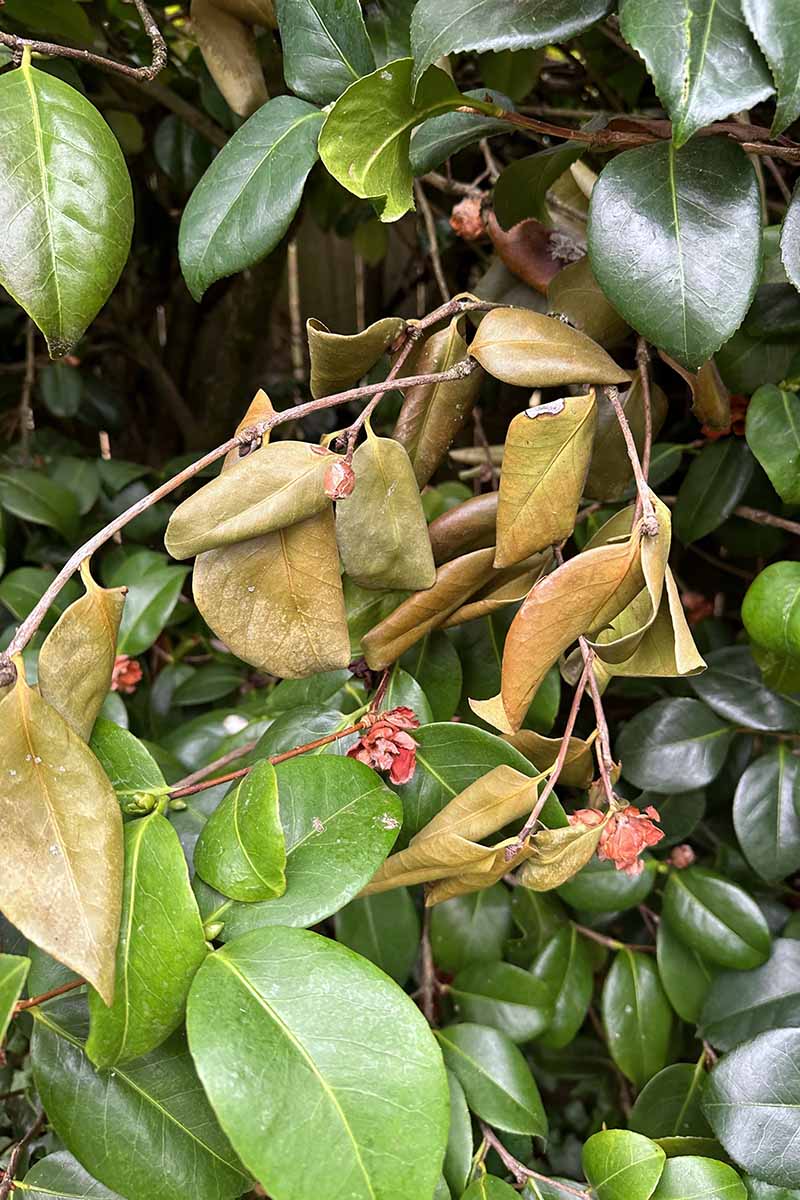
The disease can attack older branches, too. In this case, the leaves will turn brown, but they’ll stay on the branch rather than dropping. If you bend the branch, it will be brittle and will break rather than bending.
If you scrape away the bark, you’ll notice that the wood underneath is discolored.
Most of the time, the canker isn’t visible, but it’s possible that you might see a sunken canker just below the dying areas.
If a canker forms on the main trunk, your camellia will die. Fortunately that’s rare, and you’ll likely just have to deal with some dead twigs or small branches on an otherwise healthy plant.
Still, you don’t want to give the disease a chance to become a serious problem, so address it the moment you see it.
First, prune off every symptomatic twig and branch back to the next largest branch. Then, spray the entire plant, top to bottom, with copper fungicide.
You won’t need to reapply unless you have a period of high humidity or rain within the next few weeks. If you do, reapply the copper fungicide on a dry day.
To avoid spreading the disease, always clean your tools with hot soapy water between plants.
The pathogen needs a damaged area on the plant through which to enter, so do your best to keep pests away and avoid damaging your camellia.
3. Flower or Petal Blight
If your camellia looks healthy otherwise but the flowers are rapidly turning brown and falling off after developing brown spots, it’s likely you’re looking at the effects of flower blight, also known as petal blight.
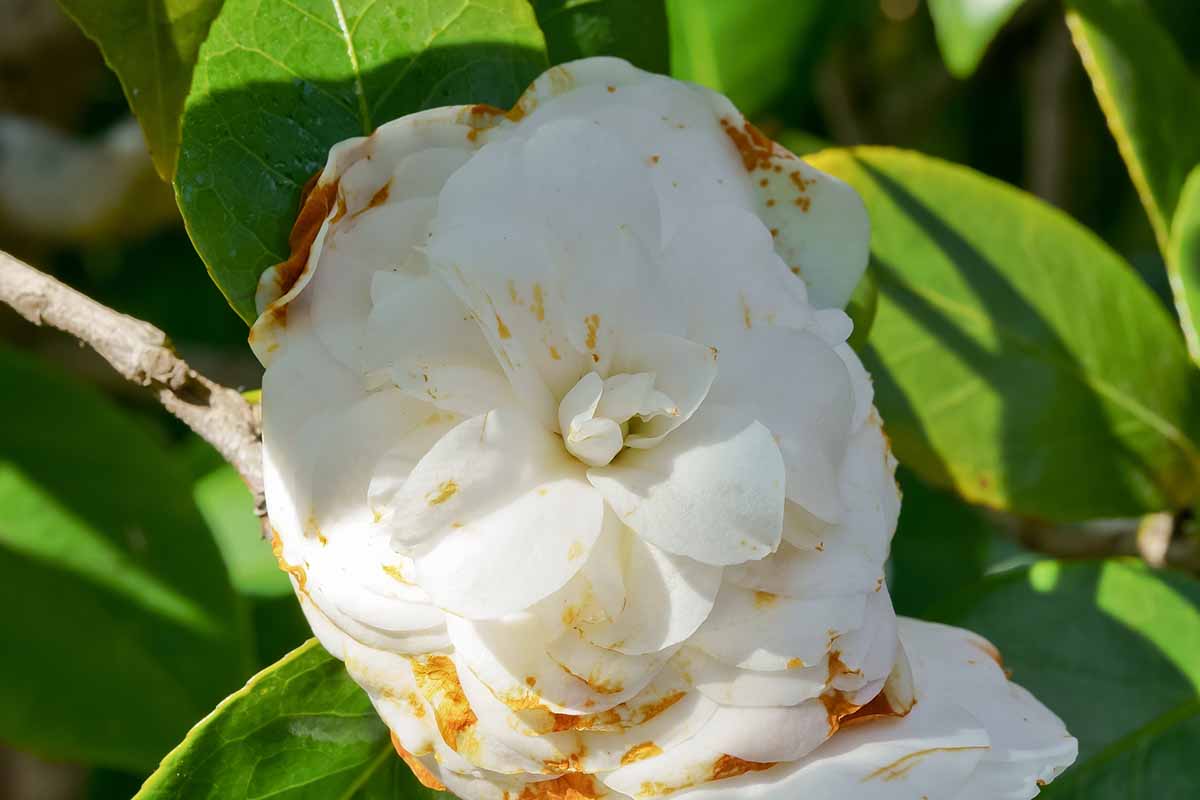
Caused by the fungus Ciborinia camelliae, it usually starts as small brown spots before the edges of the petal turn brown.
That browning spreads to the center of the petal, and the flower will fall from the plant. All of this can happen in as little as 48 hours.
Beyond depriving you of all those lovely flowers, this disease is particularly unwelcome because the fungus lives in the soil for years and can spread on the wind or water.
That means once you have one infected camellia, it’s not too long before you will likely have multiple infected plants.
You most often see this on C. japonica plants and cultivars, not because they’re more susceptible, but because the flowers open during the same time of year when the pathogen is most active.
4. Leaf Gall
Leaf gall is a disease that truly stands out. It causes the foliage on the camellia to develop yellow, cream, pink, light green, or red galls.
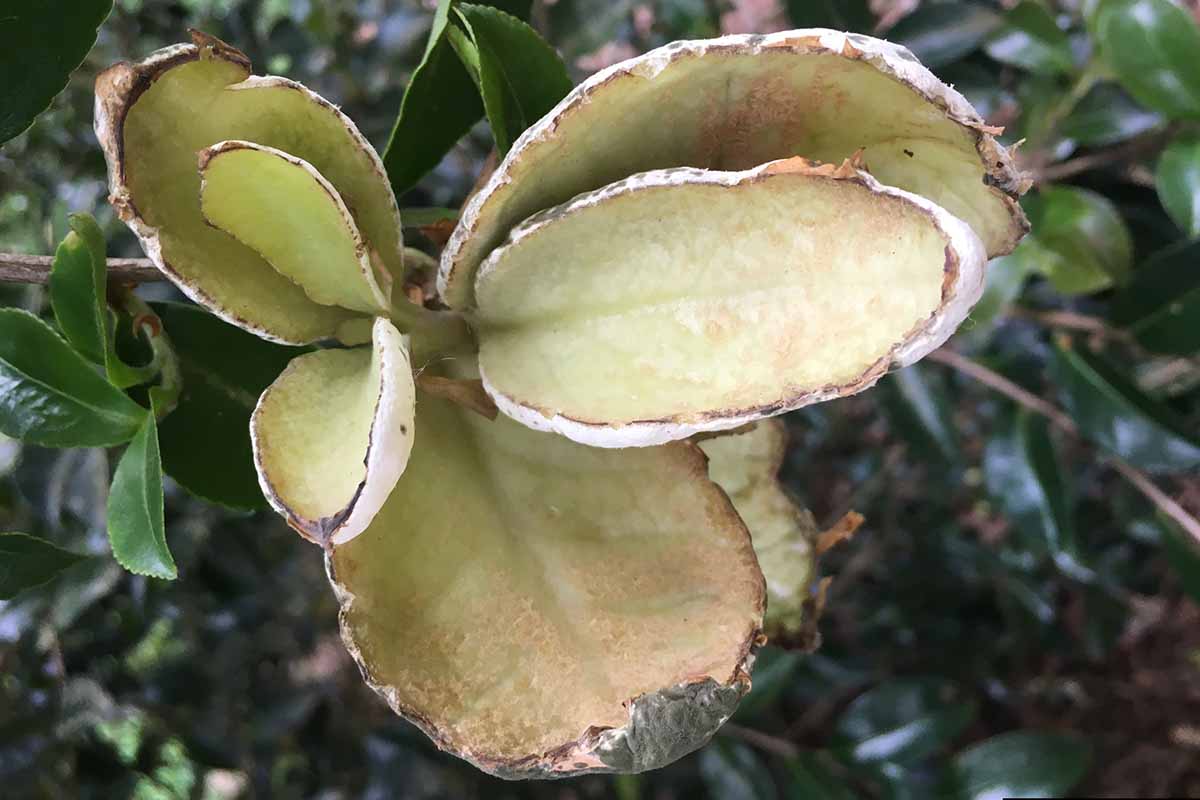
The leaves become thick as the infection spreads. If you didn’t know better, you might mistake them for succulent leaves. They eventually start to peel, revealing a white interior. This is the fungus Exobasidium camelliae, which causes the disease.
The leaves will eventually fall from the plant and land on the ground, where the fungus lives during the winter.
Leaf gall is usually seen on C. sasanqua and its cultivars, especially those grown in humid conditions.
Typically, pruning off the infected leaves before they start peeling and releasing the spores is enough to control the problem.
To learn more about this disease and how to address it, read our comprehensive guide to camellia leaf gall.
5. Phyllosticta Spot
Also known as purple-bordered spot or eye spot, Phyllosticta spot is a fungal disease caused by Phyllosticta camelliae in camellias.
As the alternate names suggest, this disease starts out as purple, semi-circular blotches on the margin of the leaves. As the spots expand, the margin remains purple while the center turns papery tan or gray. You might also see black fungal spots on the dead area.
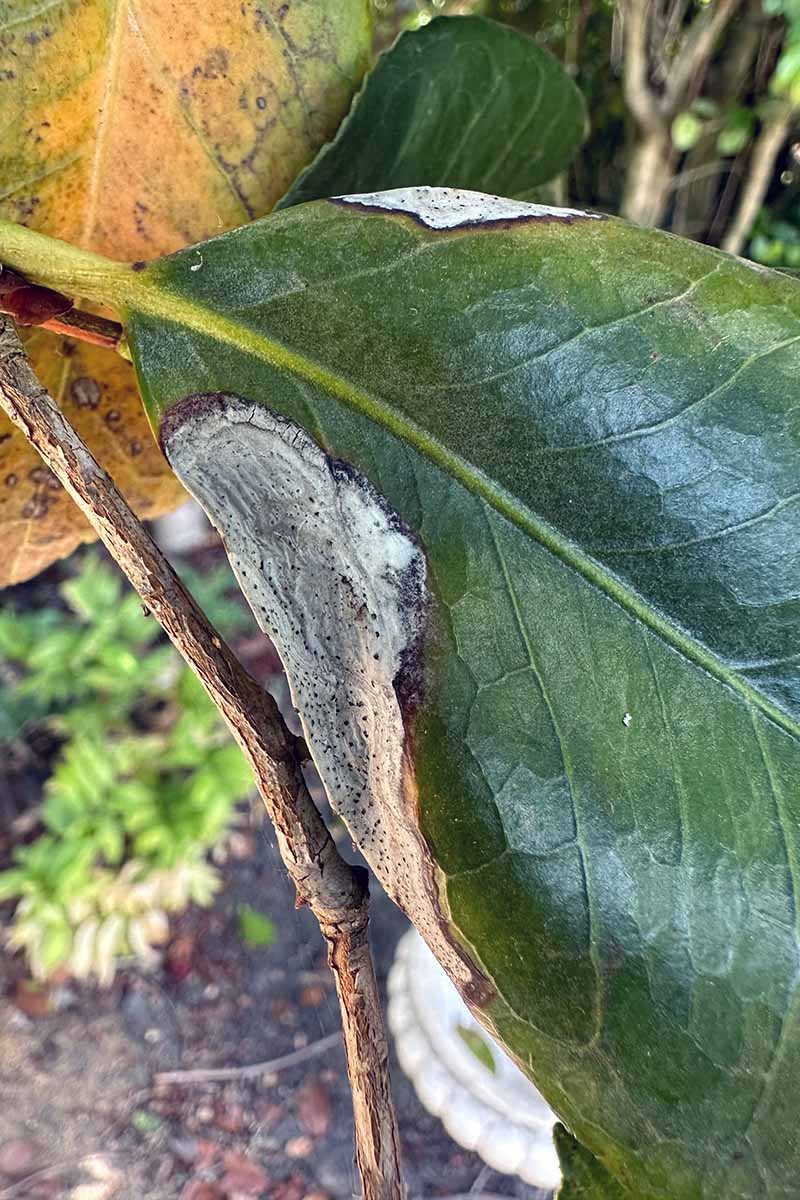
This disease can be confused with sun scorch, which causes gray or tan papery lesions. Look for the purple border and the presence of the black fungal bodies to confirm eye spot.
This disease is especially common in areas with a humid, temperate climate like the Pacific Northwest.
Unless you have a young camellia that is otherwise stressed, it won’t kill your shrub and might not require any treatment.
The easiest way to treat purple-bordered spot is to pull off infected leaves, but you can also treat it in the same way you’d treat flower or petal blight.
6. Root Rot
Camellias infected with the fungus Phytophthora cinnamomi will begin to rot underground.
The roots will turn black and mushy, and are no longer able to take in nutrients and water for the rest of the plant to use.
When this happens, the upper parts of the camellia start to wilt. If the roots continue to rot, the leaves might turn soft and yellow, and the plant might not grow well.
The older foliage is usually the first to go, followed by the younger growth.
This can happen over one growing season, or it might happen slowly over several years. If you were to dig down into the soil, you’d see that not only were some of the roots rotting, but the infected plant doesn’t have any smaller feeder roots either.
C. sasanqua and its cultivars are resistant, so either choose one of these or one with C. sasanqua rootstock if you have challenging soil that doesn’t drain well, or if rot has been a problem in your garden in the past.
7. Viruses
So, here’s the thing. You never want a disease to turn up in your garden. Diseases are, by definition, bad. But I kind of don’t hate this one.
Camellia ring-spot virus 1, 2, 3, and 4 (formerly referred to as camellia variegation virus, camellia infectious variegation virus, and camellia yellow mottle virus) causes the leaves or flowers (but not both) of plants in this genus to turn yellow, pale green, or white, to varying degrees.
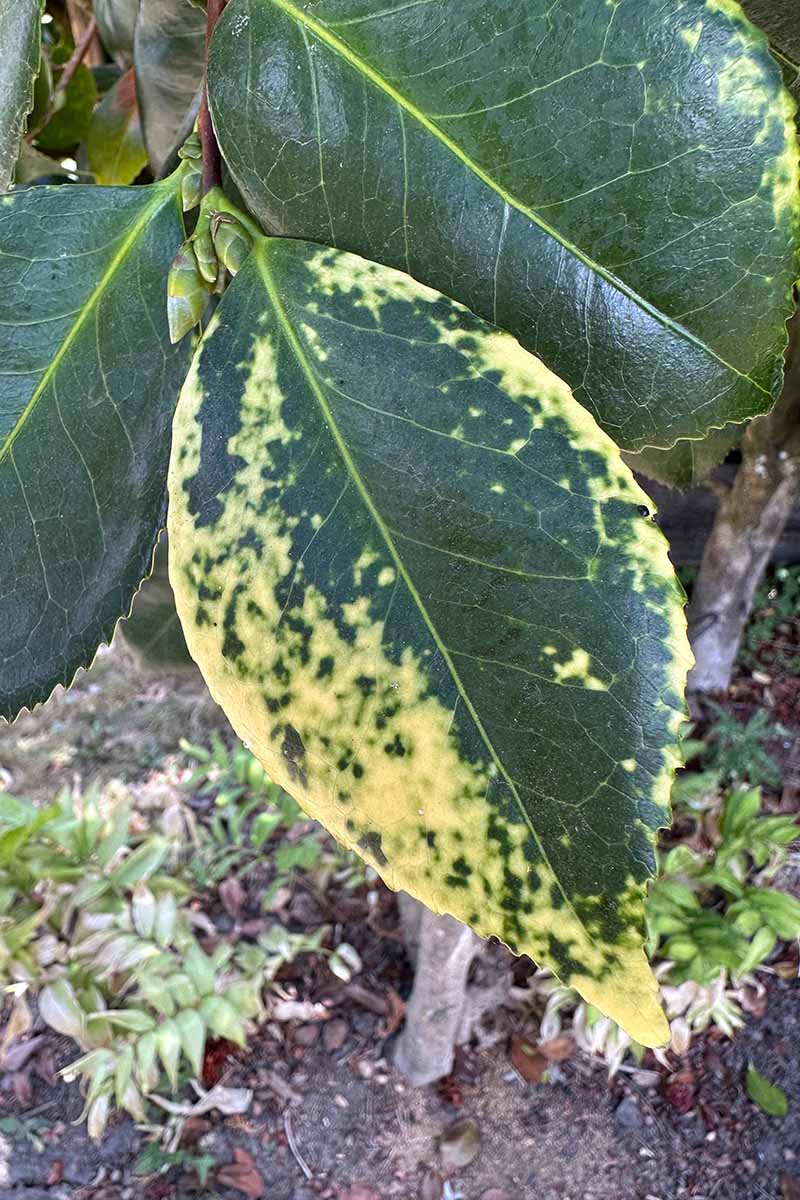
Some of the patterns that appear, which are totally random, can be quite striking. Leaves might have white and yellow mottled margins, or the entire leaf might show symptoms.
Sometimes signs of the virus disappear altogether and plants are asymptomatic, and sometimes one leaf will have yellow splotches while another nearby will have white lines.
If I could reproduce some of these patterns without spreading the disease, I would. In fact, some growers intentionally introduce the virus to young camellias to see what they can get.
The viruses that cause this discoloration are spread through cuttings and by grafting infected material onto non-infected plants.
Once a plant is infected, there is nothing you can do. But since it doesn’t spread readily, you might as well leave it and enjoy what you see. Rarely, a plant might be slightly less vigorous than it would otherwise, but that’s the worst that might happen.
Don’t confuse the symptoms of this disease with signs of low nitrogen or low iron, which causes leaves to turn entirely yellow.
This disease stands out from those physiological problems because it causes patches of color to appear, not solid yellow leaves.
Show Diseases the Door
I know a lot of people who have torn out fussier plants like roses to replace them with reliable camellias. I get it.
Camellias are pretty tough and, as you can see, even the diseases they do experience are rarely fatal or bad enough that you need to pull the plant.
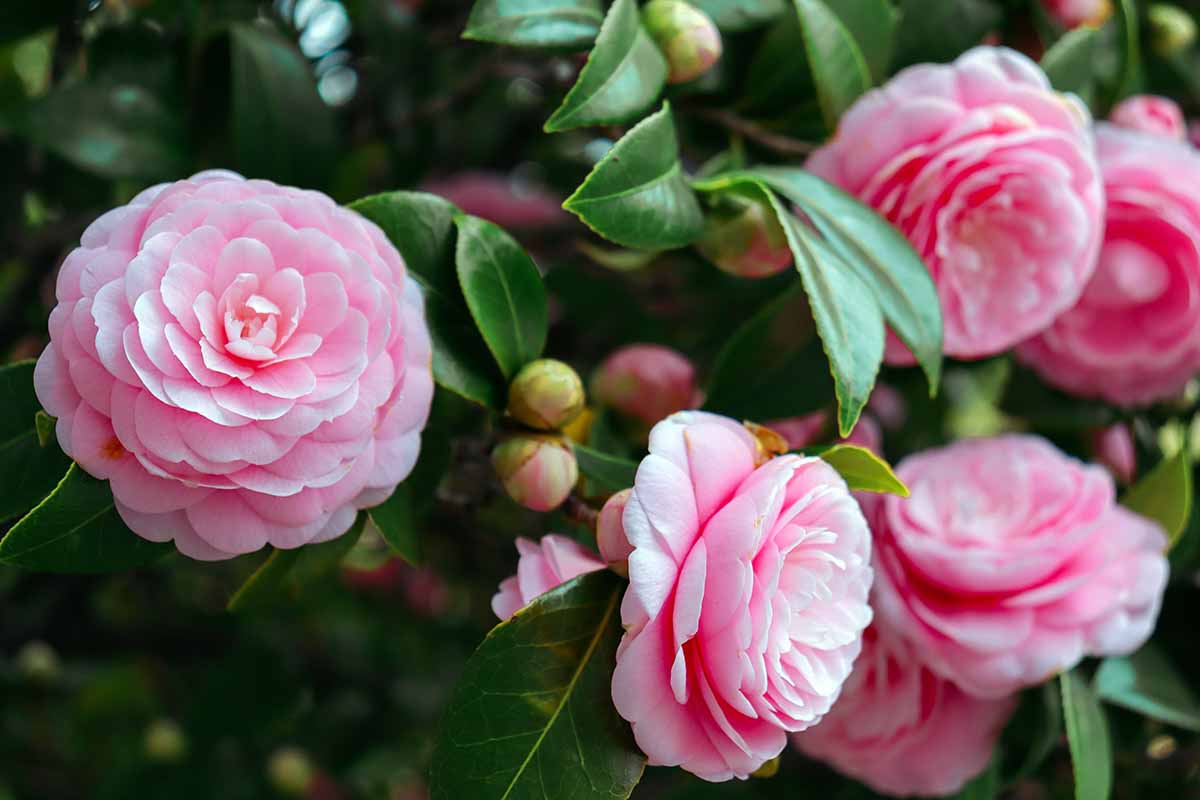
Which disease do you think your camellia is experiencing? What symptoms do you see? Let us know what’s going on in the comments.
Being able to identify a disease isn’t the only thing you need to know to grow big, happy camellia plants. If you’d like to expand your knowledge even further, you might find these guides helpful:
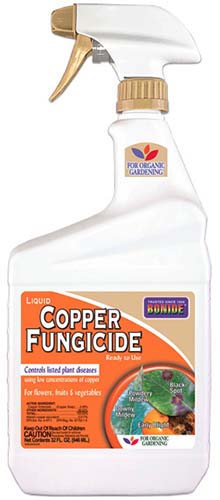
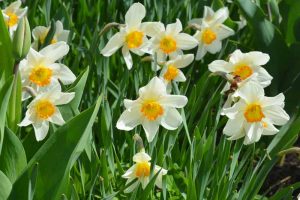
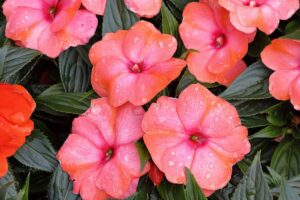
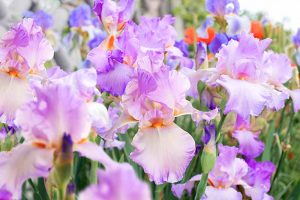
Great but you didn’t say how to treat flower rot when the flower or petals go brown.
Hi Alison, unfortunately, if your plants have blight, there isn’t a good solution. Just do your best to clean up any fallen material, and you can spray after the flower buds develop with a copper fungicide to try and reduce the symptoms (you can find Gonide’s excellent copper fungicide at Arbico Organics). Once it’s in your garden, you probably won’t be able to get rid of it; you can just reduce the impact.
Kristine, my yuletide camellia leaves have corky raised brown spots on back and flat brown spots on front of leaves.. What do you think this is? I live in Houston area.
Hi Sue Ann, without seeing pictures, it sounds a bit like leaf blight. If you examine the bumps closely, do you see any black spots? If so, this is the fruiting fungal bodies of the pathogen that causes the disease (Monochaetia karstenii or Pestalotiopsis species). If that’s what you have, a good broad fungicide can help. Copper fungicide is my go-to. Spray the plant once a month until no new symptoms develop.
We purchased a house with a camellia tree on the property that looks very sad. Some of the leaves have the yellowing, some have white spots, and some look very veiny. Not sure how to treat the camellia to save it.
Hi Carole, I’ve been there. I had to rehab a few of the camellias on the property I bought last year. The yellowing is a virus that won’t harm the plant, so don’t worry about that aspect. It can spread to other camellias, though, so if you can’t stand it, you’ll need to remove the plant because you can’t cure it. The round spot on the leaf with viral discoloration and the raised lines are likely Phyllosticta leaf spot. We talk about that above. The white spots could either be algal spots, but they look more like tea scale. Scale… Read more »
What do you think about this pictures?
Hi Paola, this looks like chlorotic ringspot virus, which can be caused by several different viruses including Prunevirus and Capillovirus. As it’s a viral disease, there isn’t much you can do to control it. It could spread to other camellias, so if you’re worried about that, you’ll want to remove the plant.
I have something going on with my camellias. See the pictures below. It’s a dwarf Purple Haze. What is it and how do I treat it?
Thank you,
Cathy
Hi Kristine! Any idea what this could be? We’ve had a number of camelias succumb to this issue. Several plants show this leaf browning at the edges, and one at a time, a plant will start to also generally yellow and wilt. Previously have just hard pruned the affected areas.
Hi Dominic are you able to share pictures? That would help us identify what the problem might be. Thanks!
I’d love your help with mine! My newer leaves look healthier than my old leaves. It also gets more sun than it used to as I cut down a big tree. It receives afternoon shade though. Am I over watering it?
Noticed diffuse leaf browning on new growth of young Frank Hauser camellia.
Any thoughts?
Not sure what’s wrong with it .Will my Camellia survive ?